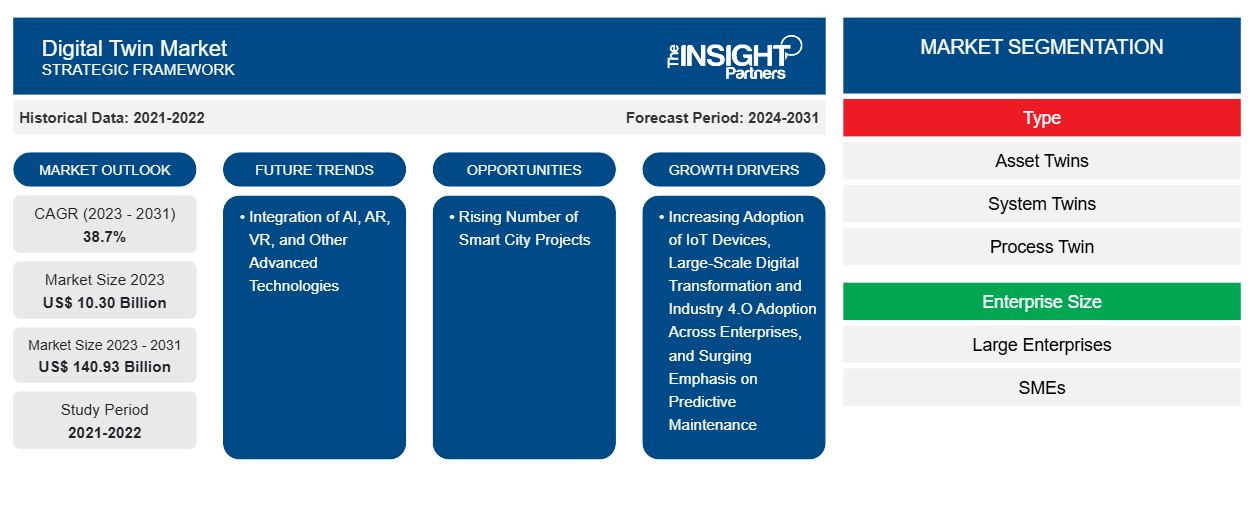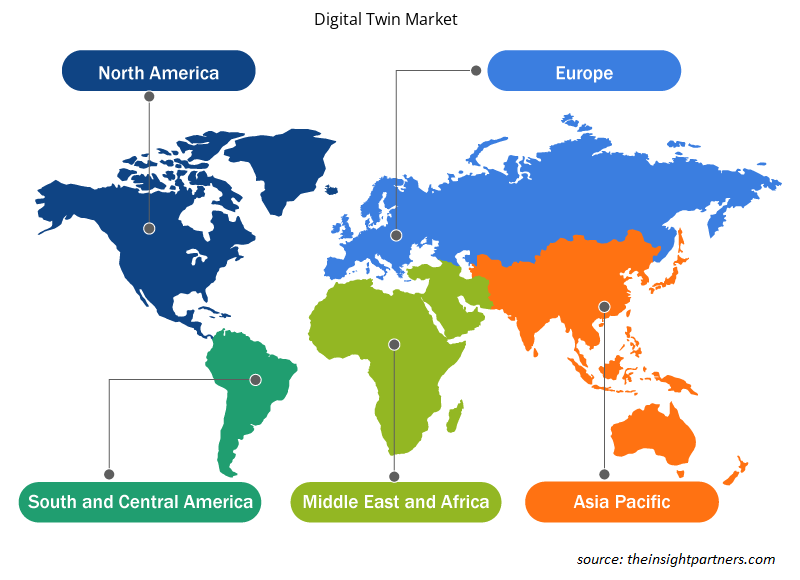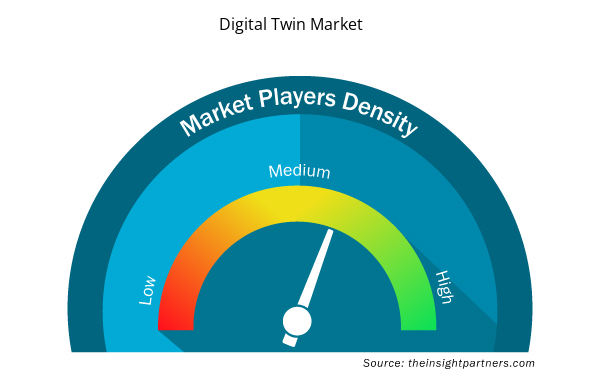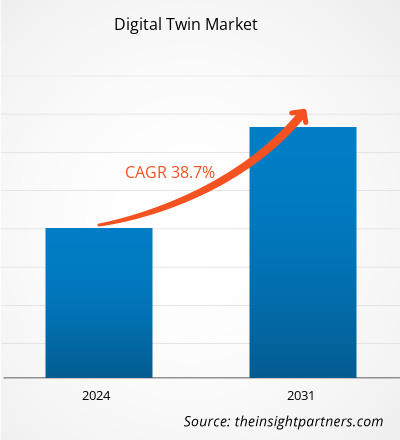The digital twin market size is expected to reach US$ 140.93 billion by 2031 from US$ 10.30 billion in 2023. The market is estimated to record a CAGR of 38.7% from 2023 to 2031. Integration of AI, AR, VR, and other advanced technologies is likely to remain a key market trend.
Digital Twin Market Analysis
The digital twin technology is revolutionizing various industries, and it has the potential to shape the future of the manufacturing industry. The increasing use of cloud solutions and services, digital transformation measures taken by governments and industrial sectors, and an emphasis on sustainability are a few of the key factors driving the digital twin market growth. Digital twins received further attention during the COVID-19 pandemic, as their use helped businesses operate efficiently without contributing to the spread of the disease. The technology aided in contactless temperature scanning of patients, intelligent traffic management, and investigative studies conducted to understand the lasting impact of COVID-19 on patients' health. The implementation of digital twins helped end users improve their performance, lower operating costs, and provide convenience on a number of levels.
Digital Twin Market Overview
Digital twins are virtual representations of real objects or environments. It is built using real-time data obtained from the sensors connected to the object and to replicate it throughout its lifecycle. Thus, a digital twin digitally replicates features, functionality, and behavior of assets, among other parameters, in the virtual environment. A wide range of real-world objects, from individual pieces of machinery in a factory to huge installations such as wind turbines and entire cities, can be replicated as digital twins. Organizations use the digital twin technology to monitor an asset's performance, detect operational issues, and determine maintenance needs; they can also utilize the asset data to predict its lifetime. Asset twins, system twins, process twins, and parts/component twins are among the different types of digital twins that are popular in various industries. Digital twins utilize advanced technologies such as artificial intelligence (AI), Internet of Things (IoT), augmented reality (AR), virtual reality (VR), and simulation to create a digital model of an object.
Customize This Report To Suit Your Requirement
You will get customization on any report - free of charge - including parts of this report, or country-level analysis, Excel Data pack, as well as avail great offers and discounts for start-ups & universities
Digital Twin Market: Strategic Insights

- Get Top Key Market Trends of this report.This FREE sample will include data analysis, ranging from market trends to estimates and forecasts.
Customize This Report To Suit Your Requirement
You will get customization on any report - free of charge - including parts of this report, or country-level analysis, Excel Data pack, as well as avail great offers and discounts for start-ups & universities
Digital Twin Market: Strategic Insights

- Get Top Key Market Trends of this report.This FREE sample will include data analysis, ranging from market trends to estimates and forecasts.
Digital Twin Market Drivers and Opportunities
Increasing Adoption of IoT Devices to Favor Market
IoT describes an extensively broad network of interconnected devices along with technologies that enable communications between these devices and the cloud. Recently, there has been a huge surge in the adoption of IoT technologies due to advancements in mobile and wireless connectivity technologies, and a gradual drop in the cost of sensors and other components. Several industries are using IoT to improve efficiency and reduce the costs of their operations. According to Finance Online, there were approximately 14.76 billion connected IoT devices as of November 2023, and this figure is expected to rise to ~25.44 billion by 2030. As per a forecast by IoT Analytics, 75% of the total devices in use would be IoT by 2030. Furthermore, FinleyUSA estimated the global IoT spending at US$ 1.1 trillion in 2023. The use of digital twins is increasing with the surging adoption of IoT. As IoT devices transmit data, digital twins update the data in real time, which ensures that the virtual model is in sync with the physical entity. By leveraging IoT, a digital twin can represent a complex piece of equipment such as a wind turbine and processes such as customer activities in a retail shop. Thus, the increasing adoption of IoT devices drives the digital twin market.
Rising Number of Smart City Projects
The reliance on technology for a more comfortable living is increasing with the evolving lifestyles of consumers and communities worldwide. Smart cities have gained huge traction in the last few decades as they can potentially facilitate a new way of living with optimized city functions, in turn enabling economic growth and improved quality of life for consumers by using smart technologies and data analysis. According to TWI Ltd., 54% of the world’s population lives in cities, and the number is expected to rise to 66% by 2050. The projected population growth indicates an increasing need to manage the environmental, social, and economic sustainability of resources with the help of smart cities. Digital twins can be used to help smart cities meet their environmental, economic, and social sustainability goals. Virtual models guide planning decisions and offer solutions to various complex challenges faced by smart cities. Smart city planners can use digital twin technology to design, monitor, and manage infrastructures such as transportation systems, water and wastewater networks, energy grids, and telecommunications. Thus, the rising number of smart city projects would provide growth opportunities for the digital twin market in the coming years.
Digital Twin Market Report Segmentation Analysis
Key segments that contributed to the derivation of the digital twin market analysis type, enterprise size, and end user.
- Based on type, the market is segmented into asset twin, system twin, process twin, and parts/component twin. The asset twin segment held the largest market share in 2023.
- Based on enterprise size, the market is bifurcated into large enterprises and SMEs. The large enterprises segment dominated the market in 2023.
- Based on end user, the digital twin market is segmented into manufacturing sector, automotive sector, aerospace & defense sector, healthcare sector, retail sector, and others. The manufacturing sector segment dominated the market in 2023.
Digital Twin Market Share Analysis by Geography
- The digital twin market is segmented into five major regions—North America, Europe, Asia Pacific (APAC), the Middle East & Africa (MEA), and South & Central America.
- North America dominated the global digital twin market share in 2023. North America is one of the fastest-growing regions in terms of technological innovations and adoption of advanced technologies. The region has witnessed huge adoption of technologies such as machine learning (ML), artificial intelligence (AI), and blockchain in the past three years across all the major industry verticals. With the rising penetration of digitization in various industries, the digital twin has become a vital component of business. In addition, the region is home to a majority of key market players, such as IBM Corporation; Oracle; Microsoft; ANSYS, Inc; and PTC, leading to the growth of the North America digital twin market.
Digital Twin Market Regional Insights
The regional trends and factors influencing the Digital Twin Market throughout the forecast period have been thoroughly explained by the analysts at Insight Partners. This section also discusses Digital Twin Market segments and geography across North America, Europe, Asia Pacific, Middle East and Africa, and South and Central America.

- Get the Regional Specific Data for Digital Twin Market
Digital Twin Market Report Scope
| Report Attribute | Details |
|---|---|
| Market size in 2023 | US$ 10.30 Billion |
| Market Size by 2031 | US$ 140.93 Billion |
| Global CAGR (2023 - 2031) | 38.7% |
| Historical Data | 2021-2022 |
| Forecast period | 2024-2031 |
| Segments Covered |
By Type
|
| Regions and Countries Covered | North America
|
| Market leaders and key company profiles |
Digital Twin Market Players Density: Understanding Its Impact on Business Dynamics
The Digital Twin Market market is growing rapidly, driven by increasing end-user demand due to factors such as evolving consumer preferences, technological advancements, and greater awareness of the product's benefits. As demand rises, businesses are expanding their offerings, innovating to meet consumer needs, and capitalizing on emerging trends, which further fuels market growth.
Market players density refers to the distribution of firms or companies operating within a particular market or industry. It indicates how many competitors (market players) are present in a given market space relative to its size or total market value.
Major Companies operating in the Digital Twin Market are:
- General Electric Co
- Microsoft Corp
- Siemens AG
- Dassault Systemes SE
- PTC Inc
- Robert Bosch GmbH
Disclaimer: The companies listed above are not ranked in any particular order.

- Get the Digital Twin Market top key players overview
Digital Twin Market News and Recent Developments
The digital twin market is evaluated by gathering qualitative and quantitative data post primary and secondary research, which includes important corporate publications, association data, and databases. A few of the developments in the digital twin market are listed below:
- Siemens and Microsoft announced their commitment to converge the digital twin definition language (DTDL) with the Thing Description standard from international standards organization W3C. By unifying both languages, customers are offered consistent modeling experiences, mitigating fragmentation in an evolving IoT landscape. With customers typically deploying a mix of vendors in their infrastructure, leading to lock-in and high integration efforts, this convergence will allow for simpler system integration and interoperability.
(Source: Siemens, Press Release, April 2024)
- Helixx, a new UK-based global technology company, selected the Siemens Xcelerator portfolio of industry software and services to assist in the design, development, validation, delivery, and management of its innovative electric vehicle manufacturing system.
(Source: Helixx, Press Release, June 2023)
Digital Twin Market Report Coverage and Deliverables
The "Digital Twin Market Size and Forecast (2021–2031)" provides a detailed analysis of the market covering the areas mentioned below:
- Digital twin market size and forecast at global, regional, and country levels for all the key market segments covered under the scope
- Digital twin market trends as well as market dynamics such as drivers, restraints, and key opportunities
- Detailed PEST/Porter’s Five Forces and SWOT analysis
- Digital twin market analysis covering key market trends, global and regional framework, major players, regulations, and recent market developments
- Industry landscape and competition analysis covering market concentration, heat map analysis, prominent players, and recent developments for the digital twin market
- Detailed company profiles
- Historical Analysis (2 Years), Base Year, Forecast (7 Years) with CAGR
- PEST and SWOT Analysis
- Market Size Value / Volume - Global, Regional, Country
- Industry and Competitive Landscape
- Excel Dataset



Report Coverage
Revenue forecast, Company Analysis, Industry landscape, Growth factors, and Trends

Segment Covered
Type, Enterprise Size, and End User

Regional Scope
North America, Europe, Asia Pacific, Middle East & Africa, South & Central America

Country Scope
This text is related
to country scope.
Frequently Asked Questions
Asia Pacific is anticipated to grow with the highest CAGR over the forecast period 2024-2031.
The North America held the largest market share in 2023, followed by Europe and Asia Pacific.
Integration of AI, AR, VR, and other advanced technologies is the future trends of the digital twin market.
The digital twin market was valued at US$ 10.30 billion in 2023 and is projected to reach US$ 140.93 billion by 2031; it is expected to grow at a CAGR of 38.7% during 2023–2031.
Increasing adoption of IoT Devices, large-scale digital transformation & Industry 4.O adoption across enterprises, and surging emphasis on predictive maintenance are the driving factors impacting the digital twin market.
The key players, holding majority shares, in digital twin market includes Microsoft Corp, Siemens AG, International Business Machines Corp, Oracle Corp, and Dassault Systemes SE.
Trends and growth analysis reports related to Technology, Media and Telecommunications : READ MORE..
The List of Companies - Digital Twin Market
- General Electric Co
- Microsoft Corp
- Siemens AG
- Dassault Systemes SE
- PTC Inc
- Robert Bosch GmbH
- International Business Machines Corp
- Oracle Corp
- Ansys Inc
- Autodesk Inc

 Get Free Sample For
Get Free Sample For